Abstract
An animal model was developed to determine if blood flow to the respiratory muscles limits oxygen delivery and thus work output during inspiratory resistance. With incremental increases in the rate of work of breathing to 15 times the resting level, blood flow to the diaphragm rose exponentially 26-fold. Blood flow to other inspiratory and a few expiratory muscles increased to a much smaller extent, often only at the greater work loads. Cardiac output and blood pressure did not change. Arterial-venous oxygen content difference across the diaphragm became maximal at low work rates and thereafter all increases in oxygen delivery during higher work rates were accomplished by increments in blood flow. Oxygen consumption of the respiratory musculature calculated by blood flow times oxygen extraction increased exponentially with increasing work of breathing and was less than the increase in total body oxygen consumption at each work load. Hypoxemia and respiratory acidosis occurred when the animals inspired through the highest resistance; blood flow and oxygen consumption were even higher than that observed during previous resistances and there was no evidence of a shift to anaerobic metabolsim in blood lactate and pyruvate levels. Respiratory failure did not appear to be a consequence of insufficient blood flow in this model.
Full text
PDF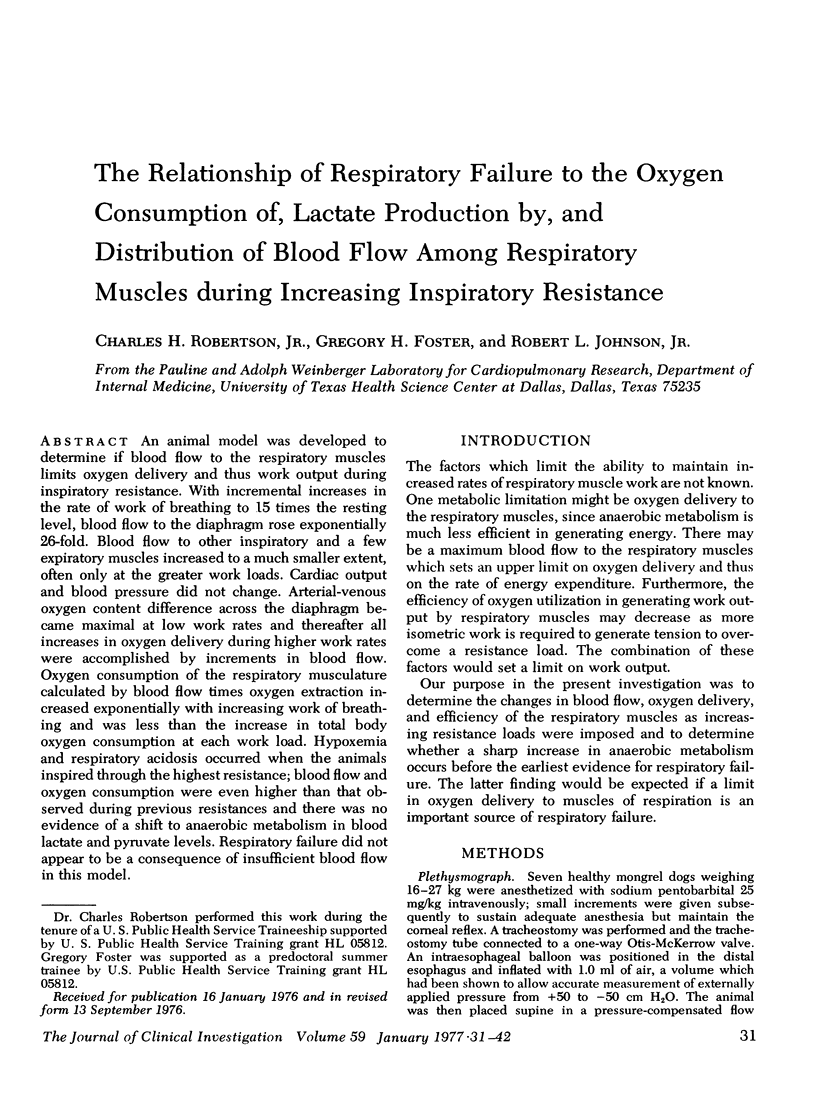
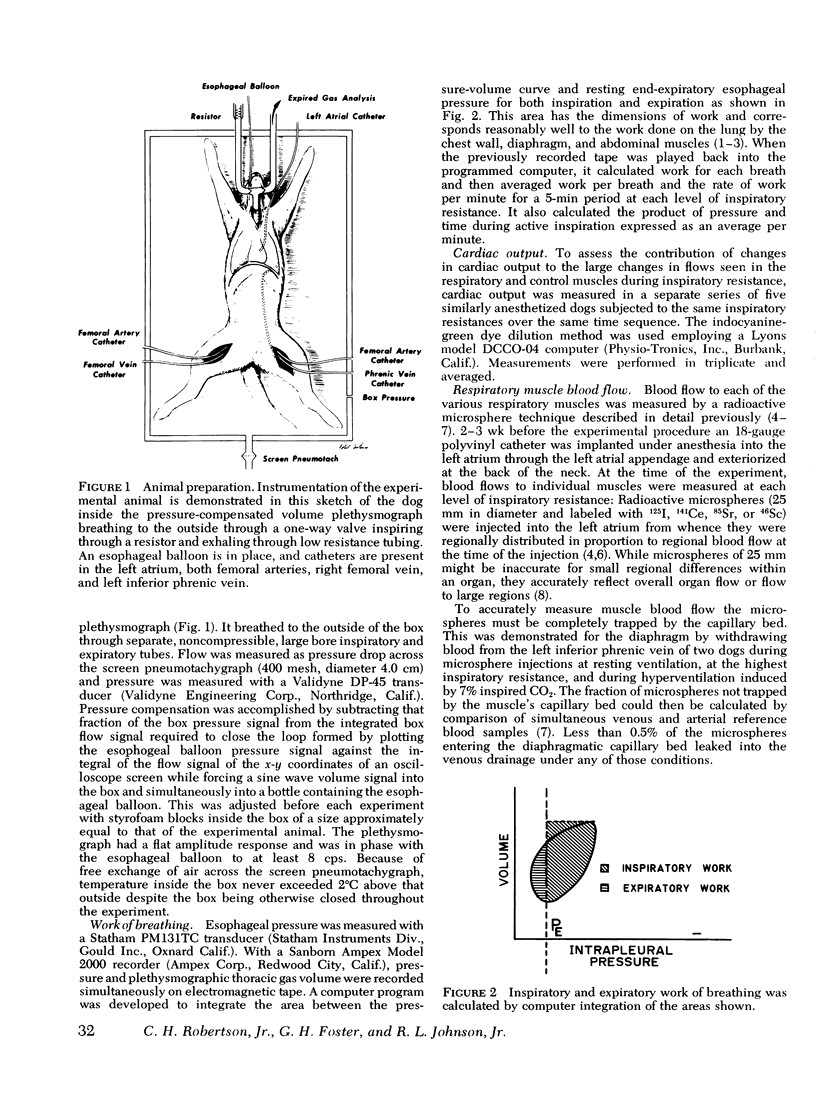
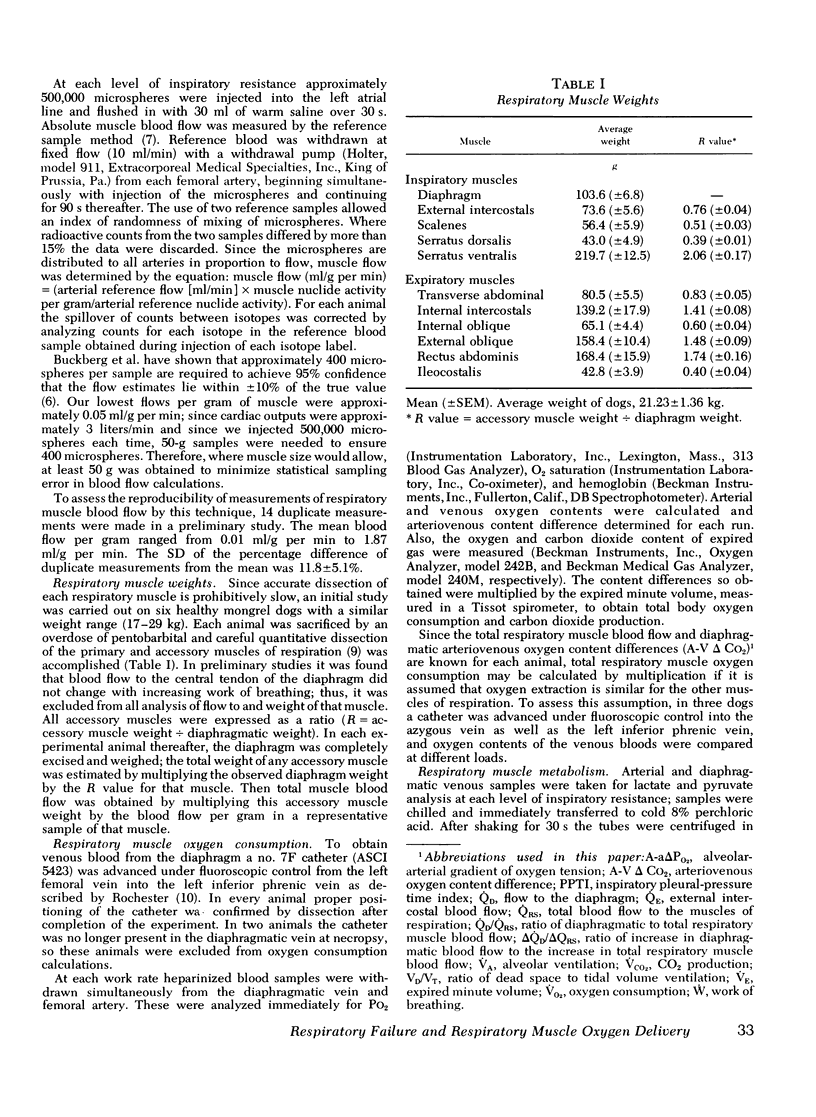
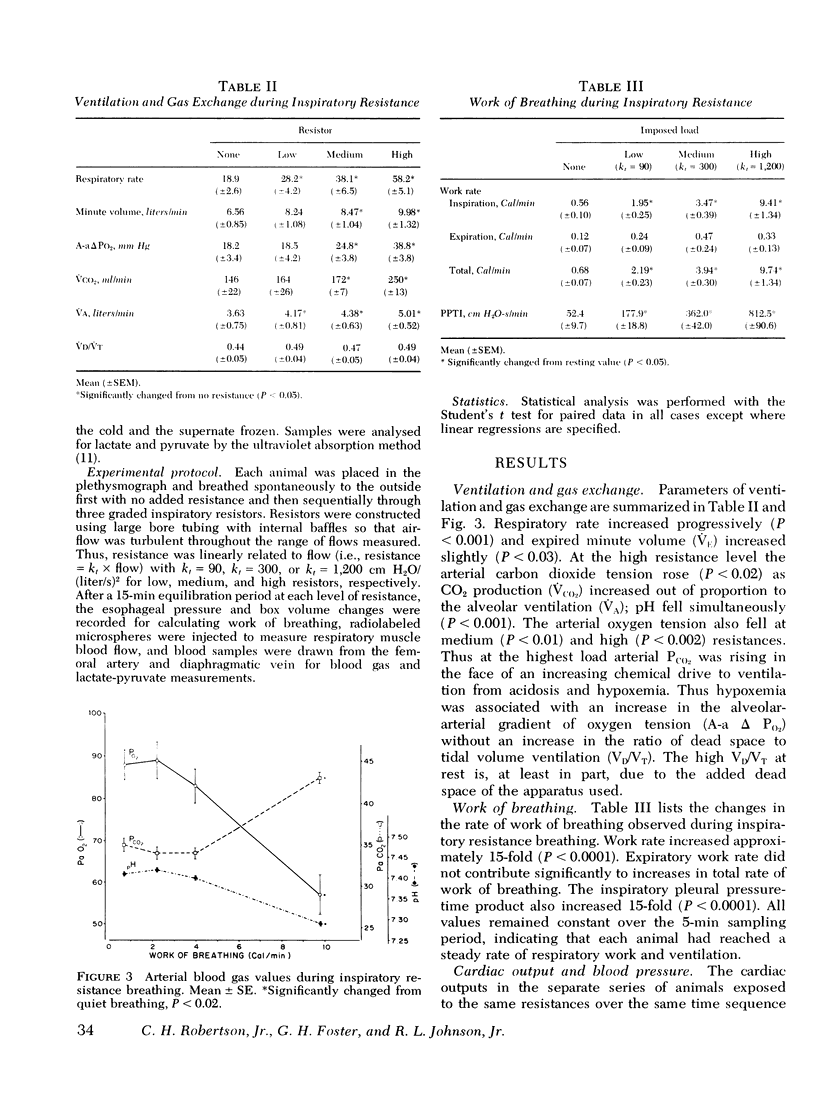
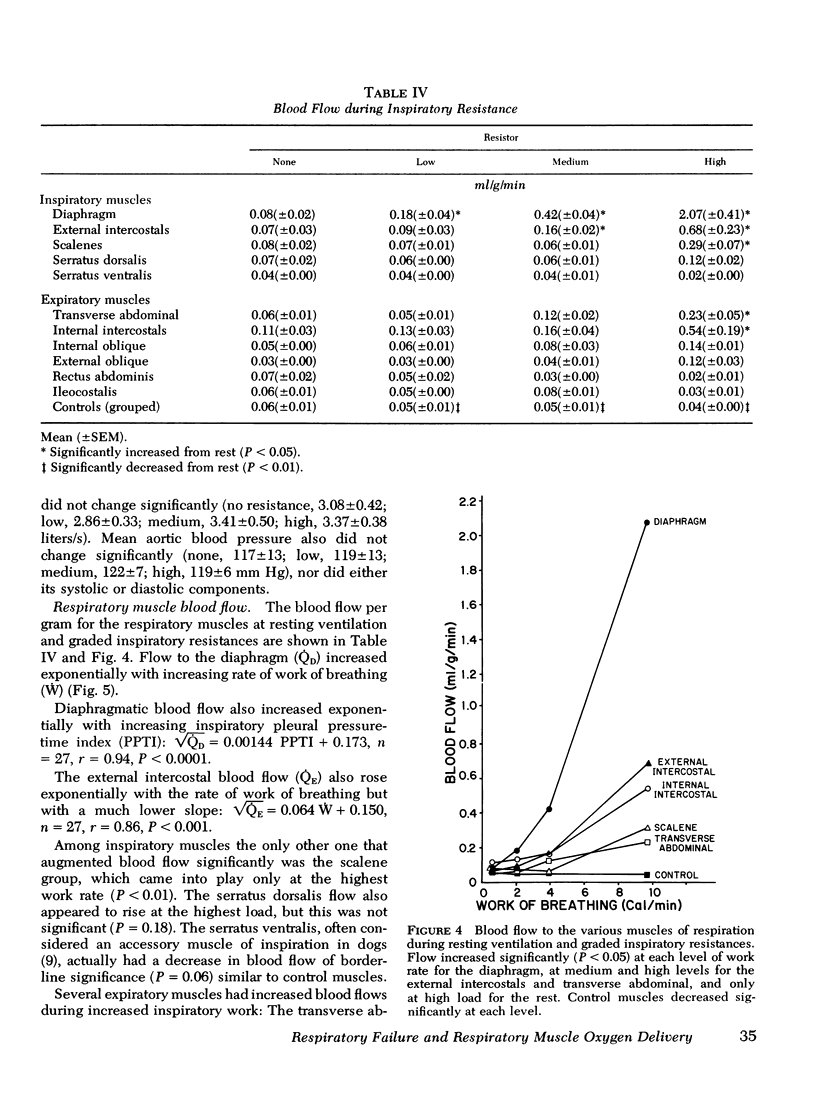
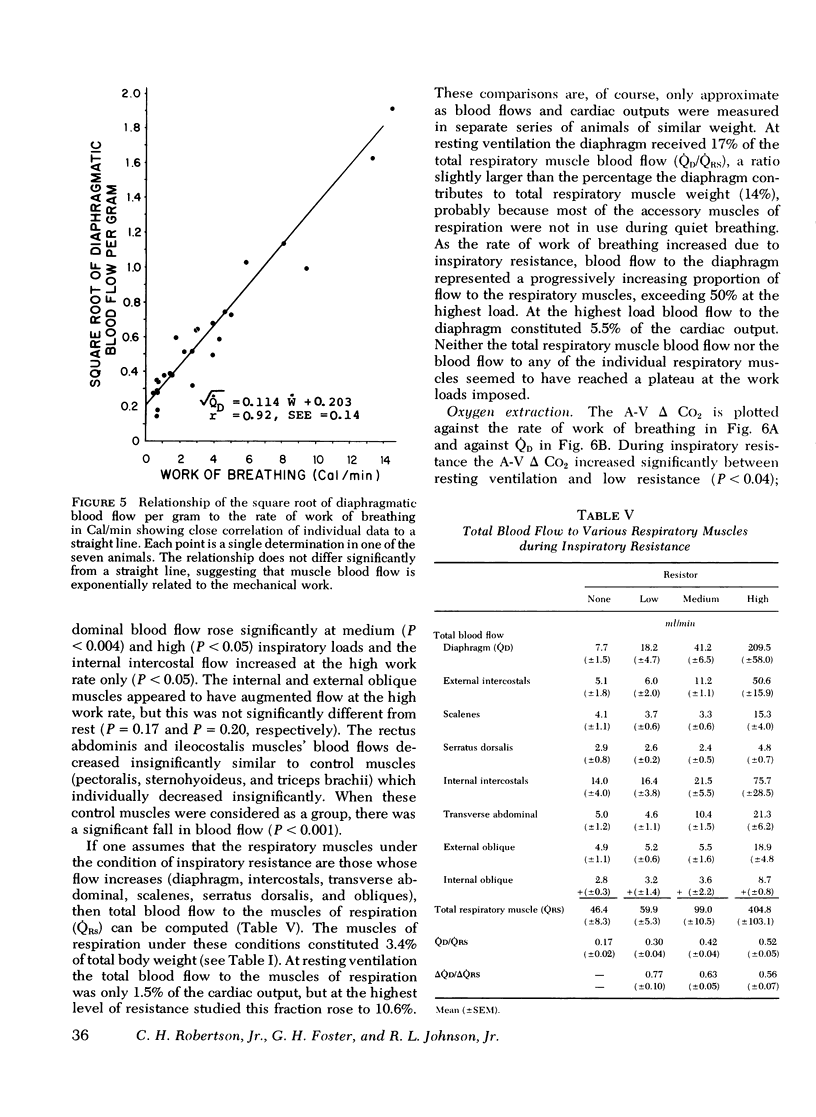
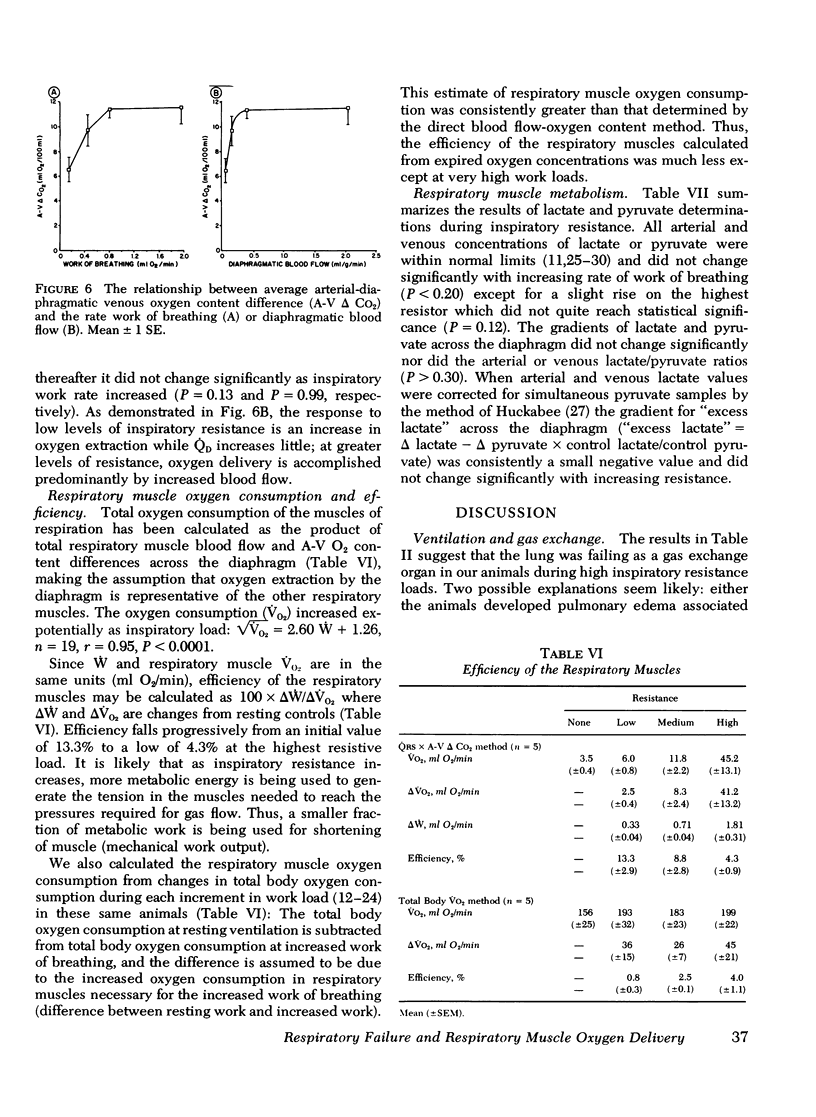
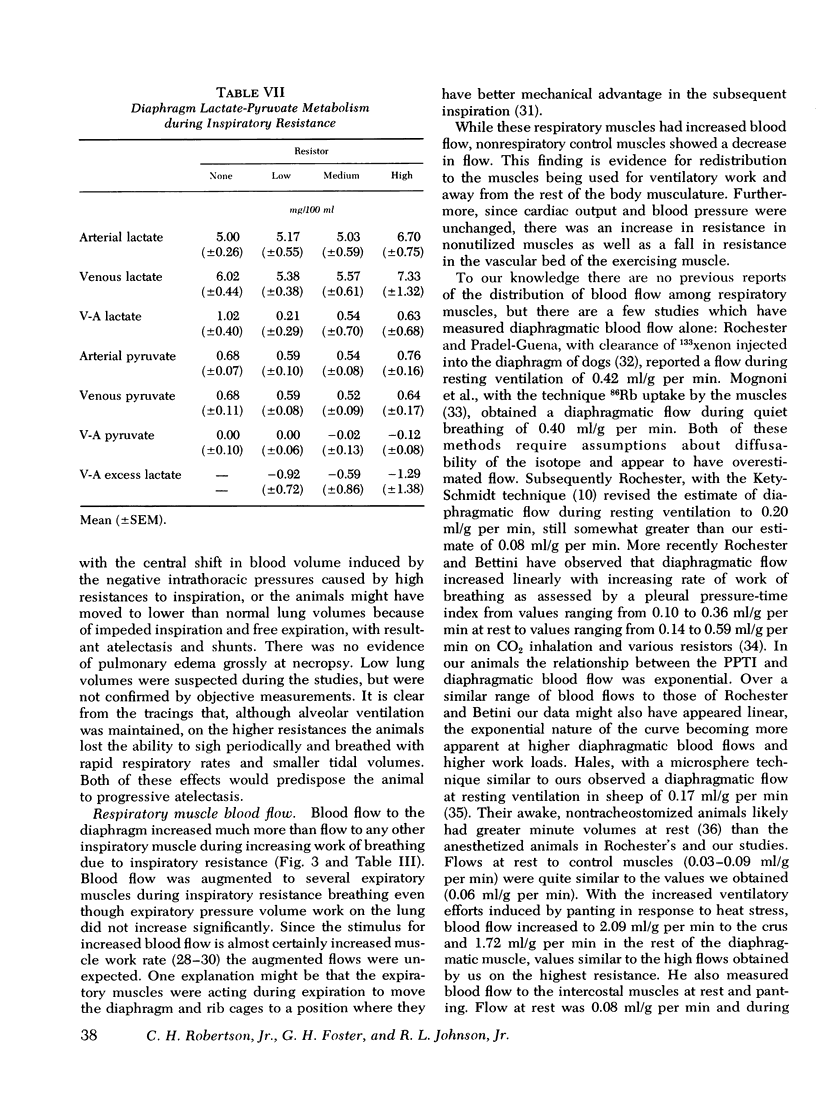
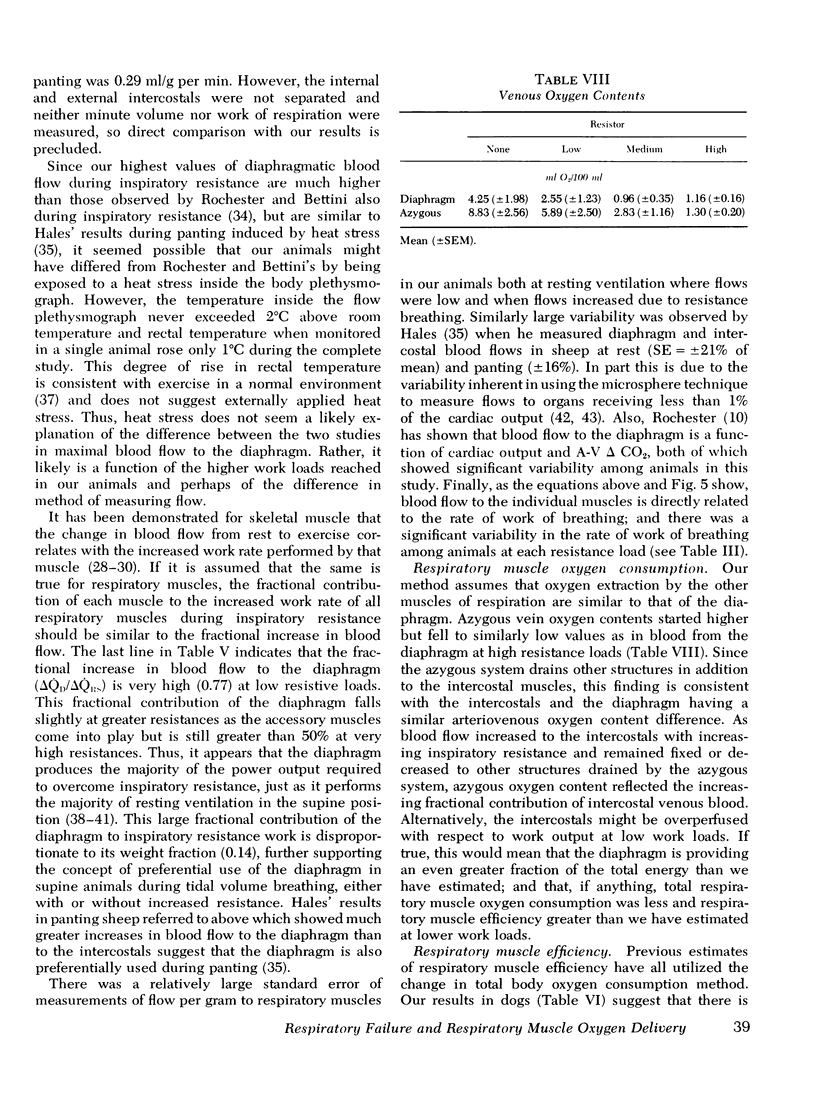
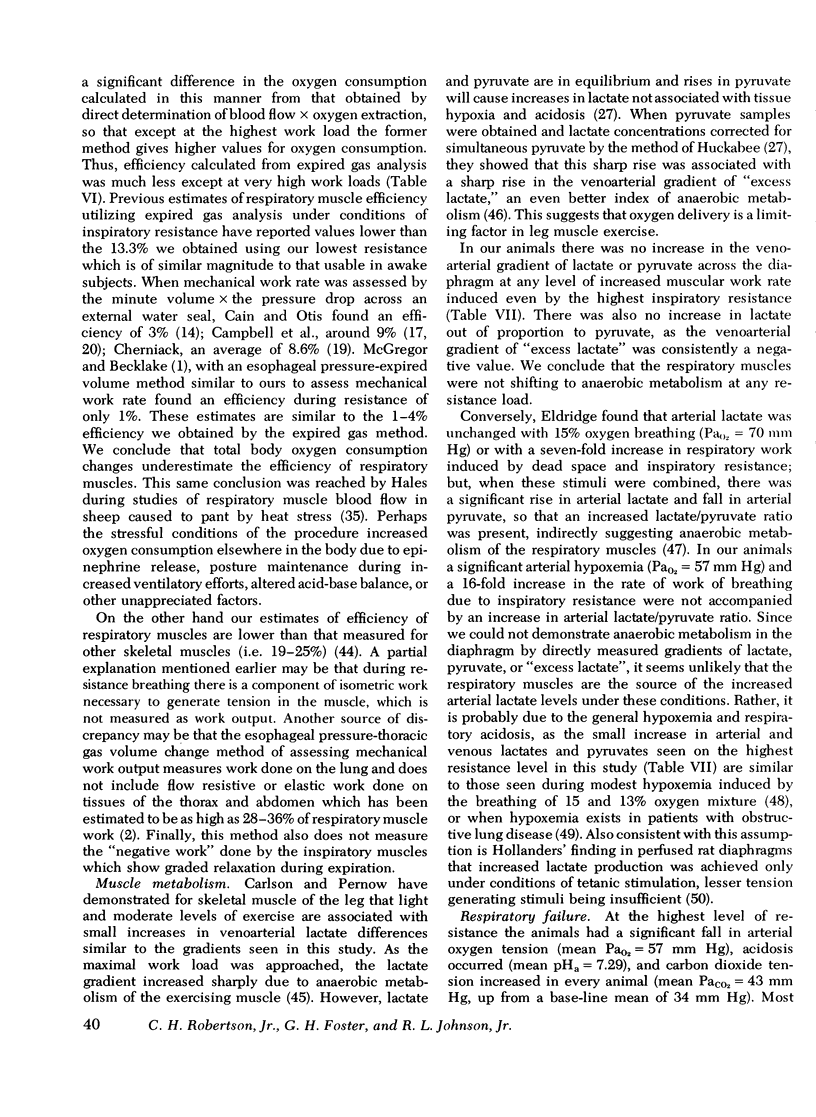
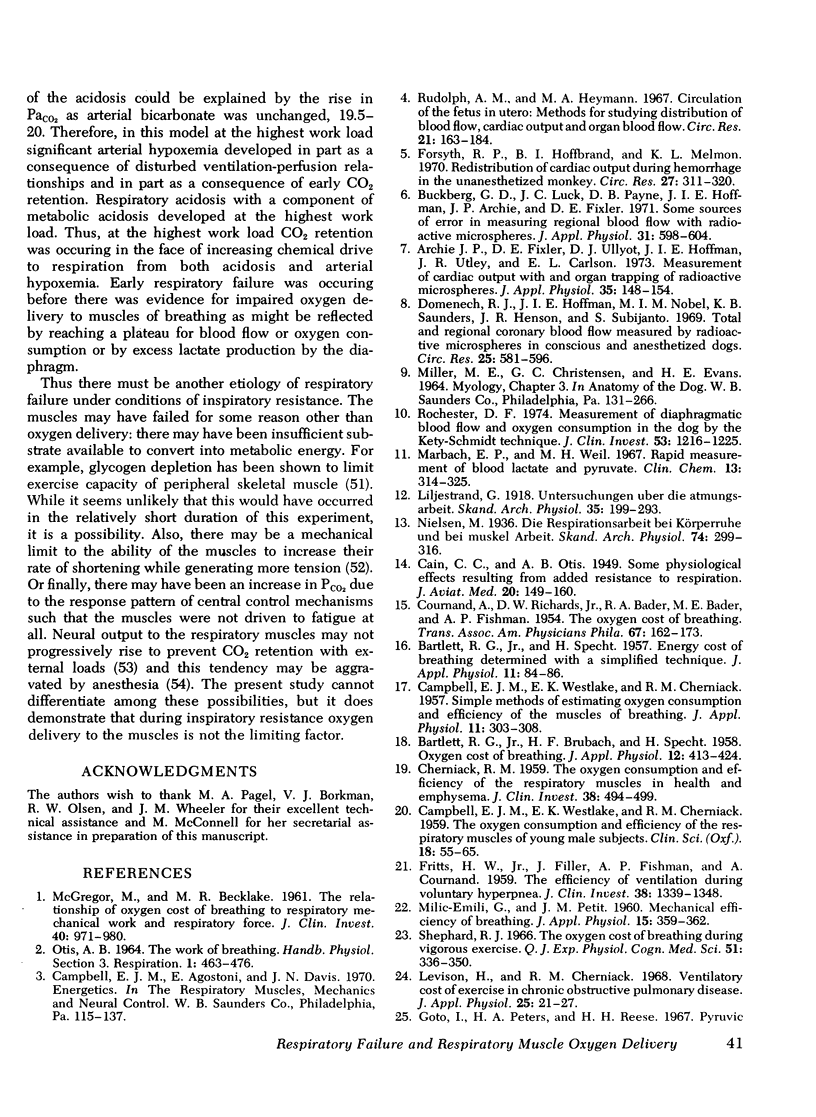
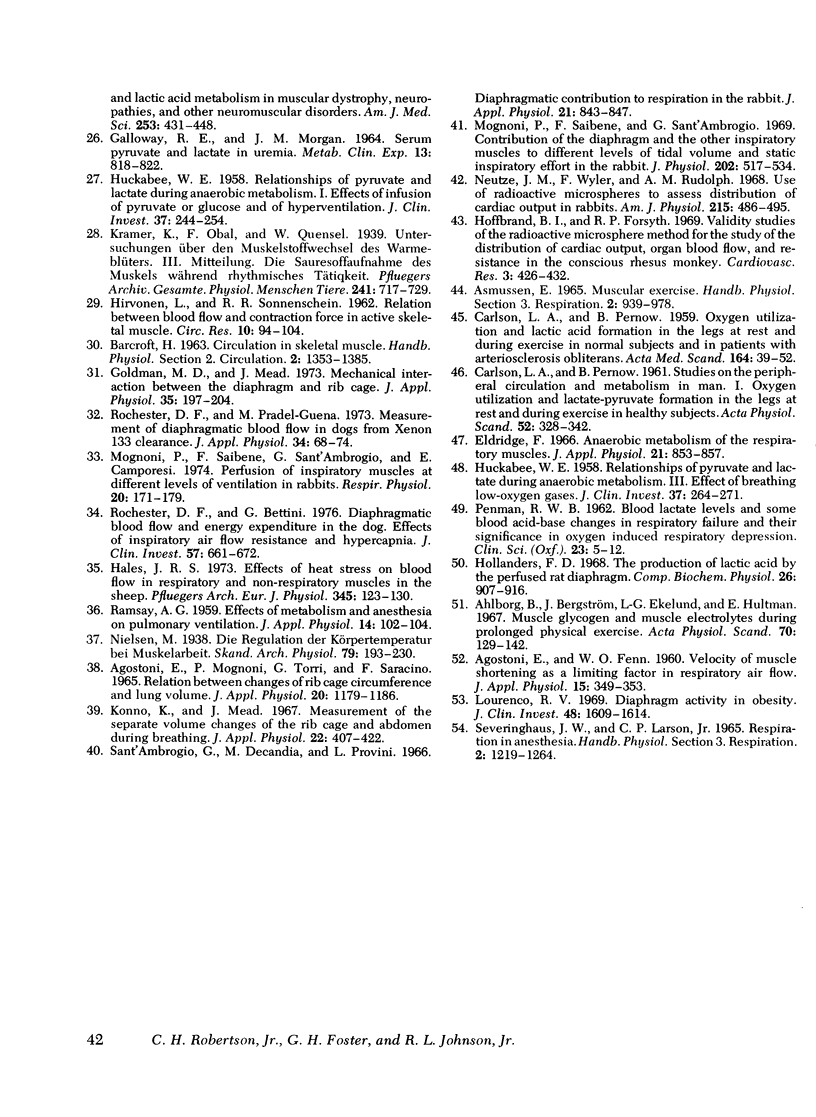
Selected References
These references are in PubMed. This may not be the complete list of references from this article.
- AGOSTONI E., FENN W. O. Velocity of muscle shortening as a limiting factor in respiratory air flow. J Appl Physiol. 1960 May;15:349–353. doi: 10.1152/jappl.1960.15.3.349. [DOI] [PubMed] [Google Scholar]
- Archie J. P., Jr, Fixler D. E., Ullyot D. J., Hoffman J. I., Utley J. R., Carlson E. L. Measurement of cardiac output with and organ trapping of radioactive microspheres. J Appl Physiol. 1973 Jul;35(1):148–154. doi: 10.1152/jappl.1973.35.1.148. [DOI] [PubMed] [Google Scholar]
- BARTLETT R. G., Jr, BRUBACH H. F., SPECHT H. Oxygen cost of breathing. J Appl Physiol. 1958 May;12(3):413–424. doi: 10.1152/jappl.1958.12.3.413. [DOI] [PubMed] [Google Scholar]
- BARTLETT R. G., Jr, SPECHT H. Energy cost of breathing determined with a simplified technique. J Appl Physiol. 1957 Jul;11(1):84–86. doi: 10.1152/jappl.1957.11.1.84. [DOI] [PubMed] [Google Scholar]
- Buckberg G. D., Luck J. C., Payne D. B., Hoffman J. I., Archie J. P., Fixler D. E. Some sources of error in measuring regional blood flow with radioactive microspheres. J Appl Physiol. 1971 Oct;31(4):598–604. doi: 10.1152/jappl.1971.31.4.598. [DOI] [PubMed] [Google Scholar]
- CAMPBELL E. J., WESTLAKE E. K., CHERNIACK R. M. Simple methods of estimating oxygen consumption and efficiency of the muscles of breathing. J Appl Physiol. 1957 Sep;11(2):303–308. doi: 10.1152/jappl.1957.11.2.303. [DOI] [PubMed] [Google Scholar]
- CARLSON L. A., PERNOW B. Oxygen utilization and lactic acid formation in the legs at rest and during exercise in normal subjects and in patients with arteriosclerosis obliterans. Acta Med Scand. 1959 May 20;164(1):39–52. doi: 10.1111/j.0954-6820.1959.tb00163.x. [DOI] [PubMed] [Google Scholar]
- CARLSON L. A., PERNOW B. Studies on the peripheral circulation and metabolism in man. 1. Oxygen utilization and lactate-pyruvate formation in the legs at rest and during exercise in healthy subjects. Acta Physiol Scand. 1961 Jul-Aug;52:328–342. doi: 10.1111/j.1748-1716.1961.tb02229.x. [DOI] [PubMed] [Google Scholar]
- CHERNIACK R. M. The oxygen consumption and efficiency of the respiratory muscles in health and emphysema. J Clin Invest. 1959 Mar;38(3):494–499. doi: 10.1172/JCI103826. [DOI] [PMC free article] [PubMed] [Google Scholar]
- COURNAND A., RICHARDS D. W., Jr, BADER R. A., BADER M. E., FISHMAN A. P. The oxygen cost of breathing. Trans Assoc Am Physicians. 1954;67:162–173. [PubMed] [Google Scholar]
- Domenech R. J., Hoffman J. I., Noble M. I., Saunders K. B., Henson J. R., Subijanto S. Total and regional coronary blood flow measured by radioactive microspheres in conscious and anesthetized dogs. Circ Res. 1969 Nov;25(5):581–596. doi: 10.1161/01.res.25.5.581. [DOI] [PubMed] [Google Scholar]
- Eldridge F. Anaerobic metabolism of the respiratory muscles. J Appl Physiol. 1966 May;21(3):853–857. doi: 10.1152/jappl.1966.21.3.853. [DOI] [PubMed] [Google Scholar]
- FRITTS H. W., Jr, FILLER J., FISHMAN A. P., COURNAND A. The efficiency of ventilation during voluntary hyperpnea: studies in normal subjects and in dyspneic patients with either chronic pulmonary emphysema or obesity. J Clin Invest. 1959 Aug;38(8):1339–1348. doi: 10.1172/JCI103909. [DOI] [PMC free article] [PubMed] [Google Scholar]
- Forsyth R. P., Hoffbrand B. I., Melmon K. L. Redistribution of cardiac output during hemorrhage in the unanesthetized monkey. Circ Res. 1970 Sep;27(3):311–320. doi: 10.1161/01.res.27.3.311. [DOI] [PubMed] [Google Scholar]
- GALLOWAY R. E., MORGAN J. M. SERUM PYRUVATE AND LACTATE IN UREMIA. Metabolism. 1964 Sep;13:818–822. doi: 10.1016/0026-0495(64)90048-4. [DOI] [PubMed] [Google Scholar]
- Goldman M. D., Mead J. Mechanical interaction between the diaphragm and rib cage. J Appl Physiol. 1973 Aug;35(2):197–204. doi: 10.1152/jappl.1973.35.2.197. [DOI] [PubMed] [Google Scholar]
- Goto I., Peters H. A., Reese H. H. Pyruvic and lactic acid metabolism in muscular dystrophy, neuropathies and other neuromuscular disorders. Am J Med Sci. 1967 Apr;253(4):431–448. doi: 10.1097/00000441-196704000-00006. [DOI] [PubMed] [Google Scholar]
- HIRVONEN L., SONNENSCHEIN R. R. Relation between blood flow and contraction force in active skeletal muscle. Circ Res. 1962 Jan;10:94–104. doi: 10.1161/01.res.10.1.94. [DOI] [PubMed] [Google Scholar]
- HUCKABEE W. E. Relationships of pyruvate and lactate during anaerobic metabolism. I. Effects of infusion of pyruvate or glucose and of hyperventilation. J Clin Invest. 1958 Feb;37(2):244–254. doi: 10.1172/JCI103603. [DOI] [PMC free article] [PubMed] [Google Scholar]
- HUCKABEE W. E. Relationships of pyruvate and lactate during anaerobic metabolism. III. Effect of breathing low-oxygen gases. J Clin Invest. 1958 Feb;37(2):264–271. doi: 10.1172/JCI103605. [DOI] [PMC free article] [PubMed] [Google Scholar]
- Hales J. R. Effects of heat stress on blood flow in respiratory and non-respiratory muscles in the sheep. Pflugers Arch. 1973 Dec 12;345(2):123–130. doi: 10.1007/BF00585835. [DOI] [PubMed] [Google Scholar]
- Hoffbrand B. I., Forsyth R. P. Validity studies of the radioactive microsphere method for the study of the distribution of cardiac output, orn blood flow, and resistance in the conscious rhesus monkey. Cardiovasc Res. 1969 Oct;3(4):426–432. doi: 10.1093/cvr/3.4.426. [DOI] [PubMed] [Google Scholar]
- Hollanders F. D. The production of lactic acid by the perfused rat diaphragm. Comp Biochem Physiol. 1968 Sep;26(3):907–916. doi: 10.1016/0010-406x(68)90010-8. [DOI] [PubMed] [Google Scholar]
- Konno K., Mead J. Measurement of the separate volume changes of rib cage and abdomen during breathing. J Appl Physiol. 1967 Mar;22(3):407–422. doi: 10.1152/jappl.1967.22.3.407. [DOI] [PubMed] [Google Scholar]
- Levison H., Cherniack R. M. Ventilatory cost of exercise in chronic obstructive pulmonary disease. J Appl Physiol. 1968 Jul;25(1):21–27. doi: 10.1152/jappl.1968.25.1.21. [DOI] [PubMed] [Google Scholar]
- Lourenço R. V. Diaphragm activity in obesity. J Clin Invest. 1969 Sep;48(9):1609–1614. doi: 10.1172/JCI106126. [DOI] [PMC free article] [PubMed] [Google Scholar]
- MCGREGOR M., BECKLAKE M. R. The relationship of oxygen cost of breathing to respiratory mechanical work and respiratory force. J Clin Invest. 1961 Jun;40:971–980. doi: 10.1172/JCI104336. [DOI] [PMC free article] [PubMed] [Google Scholar]
- MILICI-EMILI G., PETIT J. M. Mechanical efficiency of breathing. J Appl Physiol. 1960 May;15:359–362. doi: 10.1152/jappl.1960.15.3.359. [DOI] [PubMed] [Google Scholar]
- Marbach E. P., Weil M. H. Rapid enzymatic measurement of blood lactate and pyruvate. Use and significance of metaphosphoric acid as a common precipitant. Clin Chem. 1967 Apr;13(4):314–325. [PubMed] [Google Scholar]
- Mognoni P., Saibene F., Sant'ambrogio G., Camporesi E. Perfusion of inspiratory muscles at different levels of ventilation in rabbits. Respir Physiol. 1974 Mar;20(2):171–179. doi: 10.1016/0034-5687(74)90105-4. [DOI] [PubMed] [Google Scholar]
- Mognoni P., Saibene F., Sant'ambrogio G. Contribution of the diaphragm and the other inspiratory muscles to different levels of tidal volume and static inspiratory effort in the rabbit. J Physiol. 1969 Jun;202(3):517–534. doi: 10.1113/jphysiol.1969.sp008825. [DOI] [PMC free article] [PubMed] [Google Scholar]
- Neutze J. M., Wyler F., Rudolph A. M. Use of radioactive microspheres to assess distribution of cardiac output in rabbits. Am J Physiol. 1968 Aug;215(2):486–495. doi: 10.1152/ajplegacy.1968.215.2.486. [DOI] [PubMed] [Google Scholar]
- PENMAN R. W. Blood lactate levels and some blood acidbase changes in respiratory failure and their significance in oxygen induced-respiratory depression. Clin Sci. 1962 Aug;23:5–12. [PubMed] [Google Scholar]
- RAMSAY A. G. Effects of metabolism and anesthesia on pulmonary ventilation. J Appl Physiol. 1959 Jan;14(1):102–104. doi: 10.1152/jappl.1959.14.1.102. [DOI] [PubMed] [Google Scholar]
- Rochester D. F., Bettini G. Diaphragmatic blood flow and energy expenditure in the dog. Effects of inspiratory airflow resistance and hypercapnia. J Clin Invest. 1976 Mar;57(3):661–672. doi: 10.1172/JCI108322. [DOI] [PMC free article] [PubMed] [Google Scholar]
- Rochester D. F. Measurement of diaphragmatic blood flow and oxygen consumption in the dog by the Kety-Schmidt technique. J Clin Invest. 1974 May;53(5):1216–1225. doi: 10.1172/JCI107668. [DOI] [PMC free article] [PubMed] [Google Scholar]
- Rochester D. F., Pradel-Guena M. Measurement of diaphragmatic blood flow in dogs from xenon 133 clearance. J Appl Physiol. 1973 Jan;34(1):68–74. doi: 10.1152/jappl.1973.34.1.68. [DOI] [PubMed] [Google Scholar]
- Rudolph A. M., Heymann M. A. The circulation of the fetus in utero. Methods for studying distribution of blood flow, cardiac output and organ blood flow. Circ Res. 1967 Aug;21(2):163–184. doi: 10.1161/01.res.21.2.163. [DOI] [PubMed] [Google Scholar]
- Sant'Ambrogio G., Decandia M., Provini L. Diaphragmatic contribution to respiration in the rabbit. J Appl Physiol. 1966 May;21(3):843–847. doi: 10.1152/jappl.1966.21.3.843. [DOI] [PubMed] [Google Scholar]
- Shephard R. J. The oxygen cost of breathing during vigorous exercise. Q J Exp Physiol Cogn Med Sci. 1966 Oct;51(4):336–350. doi: 10.1113/expphysiol.1966.sp001868. [DOI] [PubMed] [Google Scholar]


